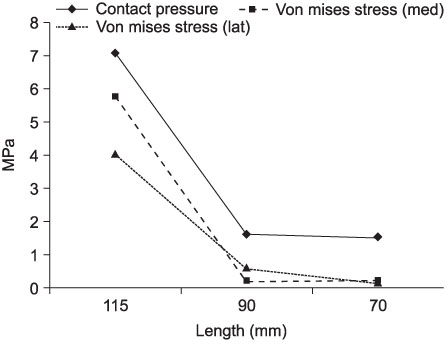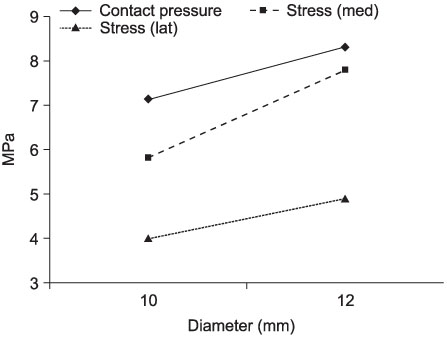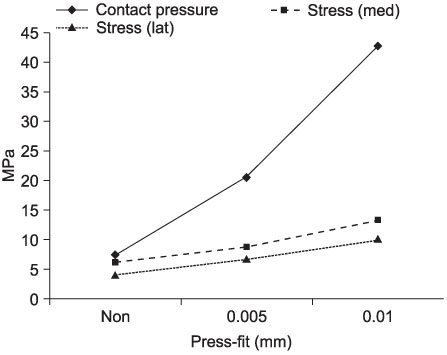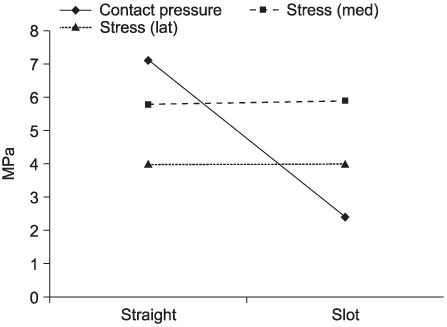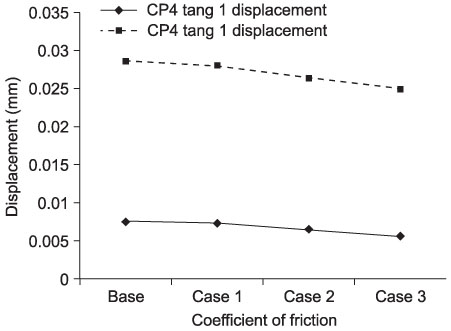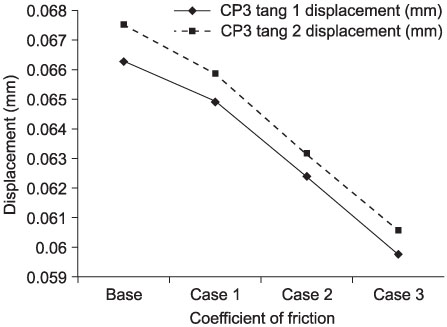J Korean Orthop Assoc.
2007 Apr;42(2):196-203. 10.4055/jkoa.2007.42.2.196.
The Biomechanical Effect of Stem Design and Methods of Fixation in Revision Total Knee Arthroplasty
- Affiliations
-
- 1Department of Orthopaedic Surgery, Uijongbu St. Mary's Hospital, The Catholic University of Korea College of Medicine, Korea. oskn@catholic.ac.kr
- 2Department of Orthopaedic Surgery, College of Medicine, Seoul, Korea.
- 3School of Advanced Technology, Kyung Hee University, Yongin, Korea.
- KMID: 854588
- DOI: http://doi.org/10.4055/jkoa.2007.42.2.196
Abstract
- PURPOSE: This study examined the effect of the stem design and method of fixation on biomechanical features around a stem tip in revision total knee arthroplasty using finite analysis. MATERIALS AND METHODS: A 3D Finite element model was reconstructed for a CT scan of the normal tibia from a 26 year old male and the CAD model of total knee arthroplasty revision was developed. The design change in the stem such as the length, diameter, slot, press fit and coefficient of friction was performed. The contact pressure, von-Meises stress around the stem and the micromotion were evaluated. RESULTS: A longer length and larger diameter press fit stem significantly increased the contact pressure and stress at the end of stem. The distal slot reduces the contact pressure and stress at the end of stem. Less displacement between the tibial component and bone was noted in the increased coefficient of friction. CONCLUSION: A stem with shorter length sufficient to engage proximal diaphysis, a closer diameter of the proximal canal and a minimal press fit can be used to reduce the contact pressure and stress if the patient's surgical anatomy such as bone loss and quality is tolerable in revision total knee arthroplasty.
Figure
Reference
-
1. Albrektsson BE, Ryd L, Carlsson LV, et al. The effect of a stem on the tibial component of knee arthroplasty. A roentgen stereophotogrammetric study of uncemented tibial components in the Freeman-Samuelson knee arthroplasty. J Bone Joint Surg Br. 1990. 72:252–258.
Article2. Au AG, Liggins AB, Raso VJ, Amirfazli A. A parametric analysis of fixation post shape in tibial knee prostheses. Med Eng Phys. 2005. 27:123–134.
Article3. Barrack RL, Rorabeck C, Burt M, Sawhney J. Pain at the end of the stem after revision total knee arthroplasty. Clin Orthop Relat Res. 1999. 367:216–225.
Article4. Barrack RL, Stanley T, Burt M, Hopkins S. The effect of stem design on end-of-stem pain in revision total knee arthroplasty. J Arthroplasty. 2004. 19:119–124.
Article5. Belmar CB, Barth PC, Lonner JH, Lotke PA. The use of fully cemented stems in revision total knee arthroplasty. J Arthroplasty. 1999. 14:263.6. Bertin KC, Freeman MA, Samuelson KM, Ratcliffe SS, Todd RC. Stemmed revision arthroplasty for aseptic loosening of total knee replacement. J Bone Joint Surg Br. 1985. 67:242–248.
Article7. Bourne RB, Crawford HA. Principles of revision total knee arthroplasty. Orthop Clin North Am. 1998. 29:331–337.
Article8. Cameron HU, Jung YB. Noncemented stem tibial component in total knee replacement: the 2- to 6-year results. Can J Surg. 1993. 36:555–559.9. Conditt MA, Parsley BS, Alexander JW, Doherty SD, Noble PC. The optimal strategy for stable tibial fixation in revision total knee arthroplasty. J Arthroplasty. 2004. 19:113–118.
Article10. Elia EA, Lotke PA. Results of revision total knee arthroplasty associated with significant bone loss. Clin Orthop Relat Res. 1991. 271:114–121.
Article11. Engh GA, Herzwurm PJ, Parks NL. Treatment of major defects of bone with bulk allografts and stemmed components during total knee arthroplasty. J Bone Joint Surg Am. 1997. 79:1030–1039.
Article12. Fehring TK, Odum S, Olekson C, Griffin WL, Mason JB, McCoy TH. Stem fixation in revision total knee arthroplasty: a comparative analysis. Clin Orthop Relat Res. 2003. 416:217–224.13. Godest AC, Beaugonin M, Haug E, Taylor M, Gregson PJ. Simulation of a knee replacement during a gait cycle using explicit finite element analysis. J Biomech. 2002. 35:267–275.14. Gofton WT, Tsigaras H, Butler RA, Patterson JJ, Barrack RL, Rorabeck CH. Revision total knee arthroplasty: fixation with modular stems. Clin Orthop Relat Res. 2002. 404:158–168.15. Goetzen N, Lampe F, Nassut R, Morlock MM. Load-shift-numerical evaluation of a new design philosophy for uncemented hip prostheses. J Biomech. 2005. 38:595–604.
Article16. Haas SB, Insall JN, Montgomery W 3rd, Windsor RE. Revision total knee arthroplasty with use of modular components with stems inserted without cement. J Bone Joint Surg Am. 1995. 77:1700–1707.
Article17. Jazrawi LM, Bai B, Kummer FJ, Hiebert R, Stuchin SA. The effect of stem modularity and mode of fixation on tibial component stability in revision total knee arthroplasty. J Arthroplasty. 2001. 16:759–767.
Article18. Kirk PG. Engh GA, Rorabeck CH, editors. Selecting an implant: a comparison of revision implant systems. Revision total knee arthroplasty. 1997. 1st ed. Baltimore: Williams & Wilkins;137.19. Luring C, Perlick L, Trepte C, et al. Micromotion in cemented rotating platform total knee arthroplasty: cemented tibial stem versus hybrid fixation. Arch Orthop Trauma Surg. 2006. 126:45–48.
Article20. Murray PB, Rand JA, Hanssen AD. Cemented long-stem revision total knee arthroplasty. Clin Orthop Relat Res. 1994. 309:116–123.21. Miyoshi S, Takahashi T, Ohtani M, Yamamoto H, Kameyama K. Analysis of the shape of the tibial tray in total knee arthroplasty using a three dimension finite element model. Clin Biomech. 2005. 38:595–604.
Article22. Nelson CL, Lonner JH, Rand JA, Lotke PA. Strategies of stem fixation and the role of supplemental bone graft in revision total knee arthroplasty. J Bone Joint Surg Am. 2003. 85:Suppl 1. S52–S57.
Article23. Parks NL, Topoleski LD. Engh GA, Rorabeck CH, editors. Revision total knee implants: materials and design considerations. Revision total knee arthroplasty. 1997. 1st ed. Baltimore: Williams & Wilkins;121.24. Parsley Brian S, Sugano Nobuhiko. Mechanical alignment of cementless stems in revision total knee arthroplasty. J Arthroplasty. 1998. 13:222.
Article25. Perillo-Marcone A, Ryd L, Johnsson K, Taylor M. A combined RSA and FE study of the implanted proximal tibia: correlation of the post-operative mechanical environment with implant migration. J Biomech. 2004. 37:1205–1213.
Article26. Peters CL, Craig MA, Mohr RA, Bachus KN. Tibial component fixation with cement: full-versus surface-cementation techniques. Clin Orthop Relat Res. 2003. 409:158–168.27. Peters CL, Erickson J, Kloepper RG, Mohr RA. Revision total knee arthroplasty with modular components inserted with metaphyseal cement and stems without cement. J Arthroplasty. 2005. 20:302–308.
Article28. Shannon BD, Klassen JF, Rand JA, Berry DJ, Trousdale RT. Revision total knee arthroplasty with cemented components and uncemented intramedullary stems. J Arthroplasty. 2003. 18:27–32.
Article29. Simon U, Augat P, Ignatius A, Claes L. Influence of the stiffness of bone defect implants on the mechanical conditions at the interface-a finite element analysis with contact. J Biomech. 2003. 36:1079–1086.
Article30. Stern SH, Wills RD, Gilbert JL. The effect of tibial stem design on component micromotion in knee arthroplasty. Clin Orthoop Relat Res. 1997. 345:44–52.
Article31. Taylor M, Tanner KE, Freeman MA. Finite element analysis of the implanted proximal tibia: a relationship between the initial cancellous bone stresses and implant migration. J Biomech. 1998. 31:303–310.32. van Lenthe GH, Willems MM, Verdonschot N, de Waal Malefijt MC, Huiskes R. Stemmed femoral knee prostheses: effects of prosthetic design and fixation on bone loss. Acta Orthop Scand. 2002. 73:630–637.33. van Loon CJ, Kyriazopoulos A, Verdonschot N, de Waal Malefijt MC, Huiskes R, Buma P. The role of femoral stem extension in total knee arthroplasty. Clin Orthop Relat Res. 2000. 378:282–289.
Article34. Vince KG, Long W. Revision knee arthroplasty. The limits of press fit medullary fixation. Clin Orthop Relat Res. 1995. 317:172–177.35. Volz RG, Nisbet JK, Lee RW, McMurtry MG. The mechanical stability of various noncemented tibial components. Clin Orthop Relat Res. 1988. 226:38–42.
Article36. Whaley AL, Trousdale RT, Rand JA, Hanssen AD. Cemented long-stem revision total knee arthroplasty. J Arthroplasty. 2003. 18:592–599.
Article37. Yoshii I, Whiteside LA, Milliano MT, White SE. The effect of central stem and stem length on micromovement of the tibial tray. J Arthroplasty. 1992. 7:433–438.
Article
- Full Text Links
- Actions
-
Cited
- CITED
-
- Close
- Share
- Similar articles
-
- Stem Fixation in Revision Total Knee Arthroplasty: Indications, Stem Dimensions, and Fixation Methods
- Three Cases of Femoral Stem Failure in Rotating Hinge Revision Total Knee Arthroplasty: Causes and Surgical Considerations
- Management of Cyst on Anterior Tibia following Cementless Total Knee Arthroplasty: Case Report
- Assessment of Failure Modes in Total Knee Replacement Arthroplasty
- Revision of the Femoral Stem

